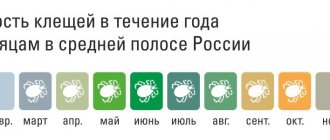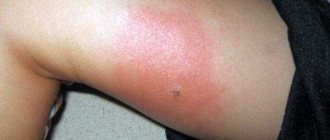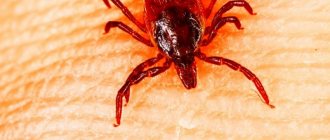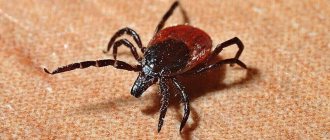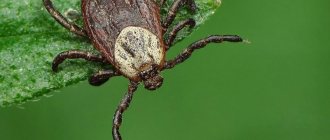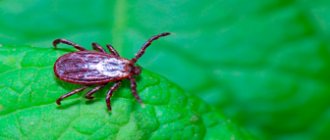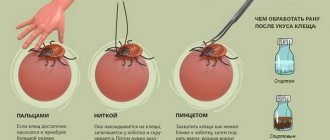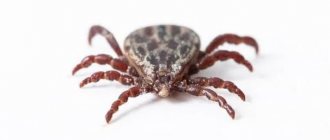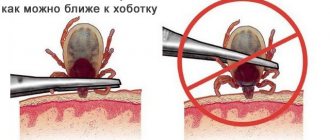Hello, dear readers! A few days ago, my husband returned from a hiking trip and told a scary story, which prompted me to write this post. My family and I live in the Rostov region and very often my husband goes with a camera “to get new shots.” Last year, in May, one of the trophies was a tick bite, which we survived with a certain amount of hysteria.
According to Rospotrebnadzor, by May 5, 2022, 31 thousand people sought medical help for tick bites - this is 1.8 times less than last year.
This time there have been no bites so far, but the prospect that arose on the last trip is, let’s say, promising. Throughout the entire hike, all he and his friend did was remove ticks from their clothes and shake off their boots. And at night, in the tent, they found a pair of bloodsuckers right under the sleeping bag. After reading a bunch of literature, I created a summary of the main points that you need to know if you or someone close to you is at risk and may be bitten by a tick.
Types of ticks. Which ticks are dangerous?
Today, science knows more than 48 thousand species of ticks. Can you imagine?! Most of them have not been studied and every year scientists discover new groups. We are interested in ixodes ticks (Ixodes), because... two representatives of this family pose a direct threat to humans - Ixodes persulcatus (taiga tick) and Ixodes ricinus (dog or European forest tick). So not all bloodsuckers are carriers of terrible infections, and if you find an unwanted guest on your body, you should not immediately faint. Moreover, even if the tick is infected, the probability of disease is not one hundred percent.
Treatment
If, after all, the tick bite has subsided and caused the development of encephalitis, you need to immediately begin its treatment, which is carried out in a hospital under the supervision of a doctor. The disease is not transmitted by airborne droplets. You can become infected only after contact with insects and by consuming raw milk. Therefore, there is no need to isolate the patient.
At an early stage of development of the pathology, the patient is shown drugs containing gamma globulin. It effectively fights the virus and prevents complications. If the disease affects the central nervous system, such medications will not be effective.
For treatment, corticosteroids, anticonvulsants, drugs that normalize the functions of the nervous and cardiovascular systems, and vitamins are used.
If the patient has complications, the following may be prescribed:
- artificial lung ventilation device;
- drugs to reduce cerebral edema;
- neuroleptics;
- drugs that reduce intracranial pressure.
During the rehabilitation period, patients are prescribed massage, physical therapy, and sanatorium-resort treatment.
Tick activity
I dug up a picture on the Internet that very well illustrates the period of tick activity by month:
The first ticks wake up at 6-8 degrees Celsius, and hibernate at the first frost. You need to know: tick activity is high both in spring and summer. As soon as the sun warms the earth and greenery appears, we immediately remember about ticks and turn on increased vigilance.
What does a tick look like (photo)
The taiga tick lives in the Asian and several regions of the European part of our country. His brother in arms, Ixodes ricinus, is more likely to be encountered by those who, like our family, settled in the south of Russia. Here is a comparative photo of all varieties of this specimen:
Ixodes Ricinus .
Male, nymph, female and tick larva. I showed my husband the photo, he said that he more often removed males from his trousers than females. I was also surprised why some mites are black, while others have a reddish tint. All ticks of this species have a powerful shell and four pairs of legs. The reddish tint of the female is due to the fact that the integument of the back part is capable of greatly stretching and absorbing hundreds of times more blood than the weight of a hungry tick.
Here is such a cute female of the genus Ixodes
To our great happiness, we did not meet a female that had drunk blood, but I will also show you a photo. For comparison and greater ostracism. God forbid you encounter something like this:
Female ticks feed for 6 to 10 days. Now let's look at the male. It is smaller and not as bloodthirsty as its “weak” half - it sticks for a short time (less than an hour). Look carefully at these photos and remember what the male and female Ixodes ricinus look like. They don’t have eyes, but they have a very strong sense of smell: they can smell prey ten meters away.
By the way, if you were bitten by a male and you didn’t notice him right away, the situation may become more complicated. After drinking blood, the tick falls off and you are rewarded with a reddened spot on the skin, the origin of which you can only guess. If you do not find out in time the nature of this stain, you risk finding yourself in a dangerous situation.
How to find out if you have contracted encephalitis
The incubation period for the disease is quite long. Therefore, there is no point in getting tested right away: they won’t show anything right away anyway. You can be examined when the first symptoms of tick-borne encephalitis appear.
If it was possible to save the insect and deliver it to the laboratory, experts will determine whether it was a carrier of a viral infection. However, even if tested positive, the person may not develop symptoms of encephalitis.
The faster the tick is removed from the body, the smaller the portion of the pathogen it will transmit to the bitten person. So he may simply not have time to infect his victim enough to develop such a serious disease.
The presence of the virus is detected by a blood test. The diagnosis is made when the level of the corresponding IgG antibodies, which the immune system produces in response to infection, increases fourfold. Then hospital treatment will be required.
Where do ticks live?
Ixodid ticks love moist and shaded areas. Most often they live in ravines, on forest edges, and on the sides of forest paths. At the moment, we need to remember about the danger even when going for a walk in a city park. Many of my friends argued and claimed that ticks jump from trees. They don't jump at all! It has been scientifically proven that ticks do not rise above 1.5 meters. In anticipation of prey, they climb onto grass stems and bush trunks and wait, and then grab with their paws anything that moves. Ticks can crawl over the body for some time and end up on the head, which is how the erroneous opinion arose that ticks live on trees.
Prevention of bites and other recommendations
The likelihood of a tick attack on a person depends on:
- epidemiological well-being of the territory of residence;
- a profession associated with frequent presence in the forest or field;
- the likelihood of visiting places unfavorable from the point of view of tick-borne infections.
Prevention of consequences associated with a tick bite is based on:
- vaccination, but this is a preventive measure; it cannot be used if a person is infected;
- specific immunotherapy is a therapeutic measure (administration of immunoglobulin only in case of infection or suspected infection after a bite);
- health insurance to pay for possible treatment;
- using special clothing and devices to prevent ticks from getting on the body;
- the use of agents to repel and kill ticks;
- limiting the number of ticks in biotopes and places where people are likely to be found.
Recommendations for choosing a vaccine
Vaccination significantly reduces the risk of disease; it is indicated for all people living in disadvantaged regions and people professionally associated with forests (drillers, geologists, surveyors, foresters). Anyone who is interested in it can be vaccinated if they wish, provided there are no contraindications.
Primary vaccination is possible from the first year of a child’s life, and then at any age. Adults can be vaccinated with domestic and imported drugs, children are better off with imported ones. In Russia, six vaccine options are available from four manufacturers from Russia, Germany and Switzerland.
Vaccines against tick-borne encephalitis produced in Russia:
- The concentrated inactivated vaccine is indicated for use from three years of age and older;
- Encevir (EnceVir), Russia, is indicated for those aged eighteen and older.
Vaccines against tick-borne encephalitis produced in Switzerland:
- FSME-Immun Junior, indicated from one year to sixteen years;
- FSM-Immun Inject (FSME-Immun Inject), similar indications.
Vaccines against tick-borne encephalitis produced in Germany:
- Encepur Children, indicated from twelve months to eleven years;
- Encepur adult, indicated for ages twelve years and older.
Two vaccination schemes: preventive and emergency:
- Preventive vaccination provides protection against ticks during the first year, and after revaccination – for three years. Repeated vaccinations are carried out every three years.
- Emergency vaccination provides a short-term protective effect. Indication: urgent trips to regions unfavorable for encephalitis.
Vaccination is carried out after a preliminary survey of the patient for allergic reactions, clinical examination, and thermometry. Persons with health problems are not allowed to get vaccinated. There are contraindications and restrictions.
In Russia, “Human immunoglobulin against tick-borne encephalitis” is produced, produced by the Federal State Unitary Enterprise NPO “Microgen”. The drug contains ready-made antibodies to viral encephalitis. It is administered intramuscularly for the purpose of treatment, usually after infection or when there is a threat of infection. Doses and frequency of administration can be obtained from your doctor.
Recommendations for insurance of expenses associated with the treatment of tick-borne encephalitis
It is advisable to recommend insurance as an addition to vaccination or as the only measure if vaccination is not possible. Insurance against tick-borne encephalitis is carried out within the framework of VHI - voluntary health insurance. Payments are provided to compensate for the costs of expensive treatment of tick-borne encephalitis and other similar infections. When choosing an insurance program and insurance company, you need to pay attention to:
- the policyholder has permits for the execution of voluntary health insurance;
- the cost of VHI services and the reputation of the policyholder;
- availability of documents for the right to provide medical and preventive care or an agreement with a person authorized to provide such assistance on behalf of the policyholder;
- Availability of a 24-hour toll-free emergency telephone line.
Recommendations for using products to repel and kill ticks
For these purposes, repellents and acaricides can be used.
Repellents repel ticks and insects - these products are suitable for application to exposed parts of the body and for treating clothing. The active ingredient is DEET (diethyltoluamide).
Preparative forms of repellents:
- Gall-RET – aerosol;
- Raptor - aerosol;
- DETA-prof - aerosol;
- Ultraton (Ultraton) USA – lotion, aerosol;
- Biban (Czech Republic) – aerosol;
- DEFI-Taiga – solution, pencil, lotion, emulsion, aerosol, balm, cream, gel;
- Off extreme – aerosol;
- Breeze anti-mite aerosol.
Acaricides (destroy ticks) - have only a contact effect. They should be used exclusively for treating outerwear fabric and anti-tick treatment of areas and premises! Modern acaricides are made based on permethrin and alphacypermethrin:
- Raftamid-taiga is an aerosol that can be used to treat an anti-encephalitis suit, dry it and wear it over underwear with long sleeves and pants. The acaricidal effect lasts up to 10-15 days;
- Picnic Anti-mite – aerosol, apply in the same way;
- Tetrix (concentrate) - a liquid suitable for treating cabins, produced in 0.25 l bottles and 1 l and 5 l canisters;
On sale you can find acaricides recommended for application to the skin. But they should be used carefully - allergies and poisoning are possible.
Recommendations for the destruction of ticks in biotopes and places where people are likely to be found
To prevent the spread of ticks, you should regularly:
- clean the bushes, remove fallen leaves (mites lose their own moisture in the sun, and restore balance in damp shelters);
- destroy small rodents that feed ticks (circulation of the pathogen in wild fauna is a natural source of infection);
- mow the grass in the area (ticks guard the victim in the grass, usually at a height of 0.6 m, maximum height is 1.5 meters; in a hungry state, ticks live from two to four years, according to some data up to seven years; development from egg to adult individuals - imago takes two to three years or more);
- carry out treatment of places where ticks are likely to be concentrated (middle zone ticks move within 5-10 meters, southern ticks - up to 100 meters, orienting with the help of receptors, concentrate along paths, forest edges - in places of likely contact with the victim).
Anti-tick treatments based on knowledge of tick biology are effective when carried out annually. In many regions there are organizations that carry out decontamination, deratization, disinfestation, sell equipment for mowing grass, and chemical agents for anti-tick treatments.
Ticks on dogs and cats
A very important point that I would not want to miss when writing my notes is the presence of ticks in pets. Owners of dogs and cats are at particular risk in the summer. If your pet does not live permanently in an apartment, be prepared to have to deal with this problem closely. I will not describe what diseases a tick causes in a dog, just like a tick in a cat. I will also not show scary photographs of poor animals bitten by ticks. Just remember - you should know that through our little brothers you can get a bunch of unpleasant surprises.
Prevention of tick-borne encephalitis
Always take extra precautions when walking in the forest. Use protective sprays and aerosols that repel insects in advance. After a walk in nature, be sure to check your entire body for foreign objects. If you notice a fever or a sharp deterioration in your health, consult a doctor immediately.
Always take extra precautions when walking in the forest. Use protective sprays and aerosols that repel insects in advance. After a walk in nature, be sure to check your entire body for foreign objects. If you notice a fever or a sharp deterioration in your health, consult a doctor immediately.
What does a tick bite look like (photo)
The area around the bite may be pink or red, depending on the body's reaction. A depression will be visible in the center. My husband was bitten by a tick early in the morning when he climbed into the grass to photograph a dragonfly. Usually, Andrey (that’s my husband’s name) tucked his jeans into his socks if he wasn’t wearing combat boots. That morning I hoped for hope. It was lucky that he noticed the “beast” quickly and pulled it out without any problems.
A red spot formed on my husband’s leg after a tick bite. He immediately circled it with a pen, for control, because... If the redness increases, I would have to consult a doctor again. If you don’t have a pen, be sure to take a photo of the bite site with your phone.
If you look closely at the previous photos of ixodid ticks, you will see the proboscis with which they pierce the human skin. This thing is called a hypostome. With its help, the tick not only sucks blood, but also “sniffs out” the victim. Typically, an attached parasite is found in this state:
After it pierces the skin, it is immediately attached inside the wound with the help of special saliva, which both anesthetizes and secures the proboscis in the wound. This is why a person does not feel the moment of the bite.
Preventive methods of protection
Prevention is the best way to protect yourself from tick-borne encephalitis, Lyme disease and other viral infections carried by ticks. There is a certain set of rules that should be followed if you do not want to become the next victim of this quiet inhabitant of our fields and forests.
Preventive methods of protection against tick bites:
- Do not wear open-toed shoes such as sandals, sandals or flip-flops.
- You should also avoid shorts and T-shirts. It is better to choose pants and outerwear with long sleeves .
- It wouldn’t hurt to tuck your pants into your sneakers/boots, or even better, into your socks.
- As for color, it is better to choose light-colored things, since small ticks are better visible on them.
- Cover your head and neck.
- You can use special mosquito nets . Today there are even fishnet suits on sale.
- Don't neglect repellents. You can treat both exposed parts of the body and things.
- Avoid tall and thick grass.
- You should not collect and take home forest flowers and herbs.
- When traveling for a long time, regularly inspect your clothing for ticks.
Remember, the best defense is not getting bitten by a tick. No bite, no problem!
Symptoms of a tick bite
Under the influence of tick saliva and microtrauma, round redness may appear on the skin of a bitten person. Sometimes, if a person is prone to allergies, angioedema or anaphylactic shock occurs. The most common symptoms that can be noticed 2-3 hours after being bitten by a tick:
- redness of the bite site;
- weakness, drowsiness;
- chills;
- aching joints;
- photophobia.
But in general, everything is individual, and depends, to a greater extent, on your physical condition. In healthy adults, everything goes unnoticed until they discover a tick on themselves. Changes that may occur later: fever, enlarged lymph nodes, headaches or muscle pain, rash on the body. Different tick-borne infections have different symptoms, so signs will appear a few days to two weeks after infection. By the way, it is impossible to distinguish a seemingly healthy tick from an infected one, and the longer it sucks blood, the higher the risk of infection.
Types of encephalitis
There are 7 types of pathology, which are combined into two groups - focal and non-focal.
- Feverish. It has symptoms of ARVI, does not disrupt the functioning of the central nervous system and does not cause serious complications.
- Meningeal. Its symptoms resemble meningitis, which is why it has this name. It manifests itself as impaired consciousness, photophobia, and stiffness of the neck muscles, which was already mentioned above.
- Meningoencephalitic. It occurs like meningitis and has symptoms of brain damage.
- Polyencephalitic. It affects the cranial nerves, affecting the bulbar group - sublingual, glossopharyngeal, vagus nerves.
- Poliomyelitis. The symptoms are similar to polio. Causes disturbances in the functioning of motor neurons in the horns of the spinal cord. This form occurs in 30% of patients.
- Polioencephalomyelitis. It is most dangerous because simultaneous damage occurs to the cranial nerves and spinal cord neurons.
- Polyradiculoneuritic. Manifests itself as a disorder of the function of peripheral nerves and roots.
The first two are non-focal forms. They flow the easiest. The febrile form manifests itself like a common cold. If the patient did not even notice the fact of the tick bite, he will not even know that he had tick-borne encephalitis. The meningeal form is more severe, but in most cases can be cured without serious consequences for health. In all other cases, recovery depends on the severity of the disease.
What should I do if bitten by a tick
Do not panic. I'm serious. Remember one simple rule: if you are bitten by a tick, DO NOT PANIC! If you can quickly get qualified help, go ahead! If not, everything in our lives sooner or later happens for the first time. With confident hands we remove the tick from the body. There are several ways to do this.
How to remove a tick
1. With your fingers. But not naked. Wrap them in a bandage, gauze, or use a sock. It is important to minimize tick contact with unprotected skin. Grasping the tick as close to its proboscis as possible, carefully unscrew it (like a screw) from the skin. It doesn’t matter which way you twist, the main thing is to keep it parallel to the bite site while removing it. 2. Use thread. Make a loop and place it around the base of the tick's sting. Gently tighten and unscrew the insect from the skin. Do everything calmly, without sudden movements. Usually 1-3 turns and the entire tick is removed along with the proboscis. 3. Use special tools such as tweezers, Klinver, Tick Nipper, lasso pen, etc. But you need to purchase them in advance at a pharmacy or tourist store.
Of the above methods, the last one is the most effective, and the first one is the most risky. I won’t describe the crazy methods, but know that they exist: removing the tick with a syringe, creating a vacuum; smothering ticks with oil; use of soap, etc. No matter how you remove the tick, always remember - you cannot tear off the head. There are salivary glands, and in them all the evil of the world. If you still screw up and the sting remains in the skin, then DON’T PANIC! Pour alcohol into the tick bite area, burn the needle, lubricate it with alcohol and carefully remove the remains from the wound, like a splinter.
I really liked the video on how to remove a tick with a thread, be sure to watch it:
Notice how calmly and quickly the father pulled this arachnid out of his son’s cheek. Well done, this is how you should behave when a child is bitten by a tick!
Where to store ticks
After all the manipulations done, you should have a reddened wound treated with alcohol (iodine, cologne), a live tick (preferably) and washed hands (since tick-borne encephalitis can be transmitted through the gastrointestinal tract). If the “little animal” is alive, we place it in a test tube, vial, or any jar with access to air. My husband wrapped it in a napkin until he got to the pharmacy. There I bought a syringe with a needle, broke off the tip, and placed the tick inside. In this state, Andrei had a chance to keep the insect alive for two days; it was during this period that the tick should be taken to a special laboratory where research is carried out on infection with tick-borne encephalitis viruses. To be completely sure that your new friend will not die before the analysis, you can place him in a clean container (test tube, jar, vial) on a piece of damp gauze, close it tightly and place it on the bottom shelf of the refrigerator. Take it to the laboratory as soon as possible. If the tick is dead, it needs to be burned or poured with boiling water, because Dead specimens are useless for research.
Where to submit a tick
The tick must be taken alive to a special laboratory. If an infection is detected in the laboratory, the patient is given anti-mite immunoglobulin. This type of treatment is called “emergency seroprophylaxis” and is relevant in the first three days after infection. If it is not possible to use immunoglobulin, then antiviral drugs may be prescribed.
Speaking of “special laboratories”. My husband, after going to the emergency department, received the following recommendations: we will take the tick, we will hand it over to the SES, and you will go straight to the emergency room. As it turned out later, there are no laboratories in our city. A week later we called the sanitary and epidemiological station, gave the name and wanted to know the result. The answer was: we don’t do analyses, we need the tick for statistics. So keep in mind that in order to get an analysis for the presence of diseases in your bloodsucker, take it to the laboratory, if there is one, of course, and do not give it to an emergency doctor.
The story with the emergency room is also interesting. The doctor immediately said: “Did you pull it out? What did he come to me? After 10 days the temperature does not rise - everything is fine, but if it rises - then come back.” This is science for those who read this post - engage in educational programs and arm yourself with knowledge. So to speak, help yourself: 10 days after the bite we donate blood for borreliosis and encephalitis. Research method - PCR. After 2 weeks - for immunoglobulins M for encephalitis, after 3 weeks - for immunoglobulins M for borreliosis. With the test results (positive), we go to the doctor. We’re not even walking, we’re flying like a “bullet,” because... the same borreliosis can be treated very well if dealt with in the early stages.
How to pull it out
The signs of a tick bite on a person have been sorted out, the bite itself has been found, now the bloodsucker needs to be pulled out.
- We treat hands, tweezers and the bite site with alcohol or chlorhexidine.
- We grab the insect with tweezers as close as possible to its head and to your skin, respectively.
- Slowly turn the tick approximately 180 degrees, perpendicular to the skin, making unscrewing movements. To remove the bloodsucker, more turns may be required, the main thing is not to rush or jerk.
- When the tick is removed, treat the bite site with alcohol or any other analogue again.
- Place the removed tick in a small glass container and close tightly.
- Take the tick to a laboratory to find out if it carried any diseases.
“If you don’t have tweezers, use a woolen thread or a lasso handle,” advises therapist Olga Fedorenko . “You can also cut off the top of the syringe, apply it to the bite site and pull out the tick under pressure.
How to get rid of a tick
What diseases do ticks carry?
Ticks transmit a lot of different nasty things. But among other things, I will highlight the main ones:
- Tick-borne borreliosis (Lyme disease)
- Tick-borne viral encephalitis
- Tick-borne typhus
- Hemorrhagic fever
In addition to those above, which are more or less well-known, there are also babesiosis, rickettsiosis, granucytic anaplasmosis, monocytic ehrlichiosis and other difficult-to-pronounce infections. The causative agents of all this nasty stuff (arboviruses) live in the saliva of the tick, but not in everyone and not in a complete set. So there is a risk of disease, but not 100%. The biggest chances (and worst) are encephalitis and borreliosis (Lyme disease).
Encephalitis
Tick-borne encephalitis leads to inflammation of the brain. No matter how cynical it may sound, but in an excellent situation you will get off with a slight fright, in a good situation you will die. But most likely you will be paralyzed. Most likely hands, or one of them. This is forever and cannot be repaired. In addition, you may become blind and/or deaf. If you are bitten by a tick in European regions, it will most likely be okay. In our country, ticks are not particularly infected - according to various sources, from a few percent to a few tenths of a percent, and 2 out of 1000 people die from tick-borne encephalitis. THIS DOES NOT MEAN THAT YOU WILL BE LUCKY. If you are bitten by a tick in Siberia or the Far East, everything is much worse. You may get Far Eastern encephalitis, and out of 100 people who get sick, 80 die from it.
The presence of encephalitis can be determined only after 10 days by donating blood for testing using the PCR method. The disease itself begins acutely, accompanied by chills, severe headache, a sharp rise in temperature to 38-39 degrees, nausea, and vomiting. Worrying muscle pain, which is most often localized in the neck and shoulders, thoracic and lumbar back, and limbs.
Borreliosis
It all starts with a high temperature and these beautiful rings at the site where the tick bite was discovered (scientifically called erythema).
Then paralysis, only this time the problems were not with the arms, but with the face. Then problems with the joints (for example, severe pain in them, to such an extent that it is impossible to move), with the heart, vision, hearing. Then the skin becomes thinner, becomes dry like parchment paper and develops bluish spots. In general, there are a lot of problems, and everyone is so different. Some citizens suffering from chronic borreliosis claim that it is worse than encephalitis. True, they assure healthy people, not those with chronic encephalitis. An important point that you should remember when encountering ticks: you can get the disease not only through an insect bite. Infection can occur when a tick is crushed at the time of removal from the body of an animal or person, if the mucous membrane of the eyes, nose, lips or damaged areas of the body is touched with unwashed hands. You don’t have to go hiking yourself, but simply host friends at home who will bring ticks with them on their clothes. I know of a case where a tick was brought into a house with wildflowers. You can also get a “gift” by eating raw milk from goats, sheep or cows, whose milk contains the virus during a mass tick attack. Moreover, not only milk will be contagious, but also products made from it: cottage cheese, sour cream, etc.
If you have encephalitis/borreliosis, it is not contagious to others - you can sneeze on them as much as you want. But if you have encephalitis and you are a nursing mother, there is a chance you can pass it on to your baby through your milk.
Popular questions and answers
In which regions is there a high risk of contracting encephalitis or borreliosis from a tick?
The majority of bites from infected ticks are recorded in the Urals, Siberia, the Far East and the regions of the Northwestern Federal District. When hiking in these regions, you need to be extremely careful, and even better, get vaccinated in advance. You need to understand that infected ticks can also be found in other parts of Russia; residents of all regions of the country seek medical help because of their bites every year.
Is it true that ticks live on trees?
In fact, ticks are usually located in tall grass, about 30 cm from the ground. This makes it easier for them to cling to the legs of those walking by. For the same reason, ticks especially like to be located near paths; they sense where people and animals most often walk. Sometimes ticks climb onto bushes and lower branches of trees.
Where do ticks usually bite?
A tick bite on a person is usually located in places where the skin is thin; it is easier for the tick to bite through it. They stick in the groin, on the stomach and lower back, in the armpits, on the chest, behind the ears, on the neck and on the scalp. A tick bite on a person looks like a red round spot, and the tick itself, as a rule, is located on it, plunging its proboscis under the skin.
Is it possible to fill a tick with oil or alcohol?
A common misconception is that if you pour oil, gasoline, alcohol, or grease onto a tick, it will suffocate and fall off on its own. Nothing of the kind, with your manipulations you can only spur the tick to stick tighter. It is better to treat the tick bite with antiseptics, for example, alcohol or vodka, just water and soap will do, and then pull it out with tweezers.
What to do if it is not possible to take a tick for analysis?
Observe the condition of the injured person. If the inflammation at the site of the tick bite disappears within 1-2 days, the likelihood of developing any disease is considered minimal. If the swelling remains or worsens, go to the doctor. It will not be superfluous to constantly change the temperature of the victim. If it increases within 10 days of the bite, there is a serious risk of developing an infection, so do not delay visiting a doctor.
What if after a bite you start taking antibiotics just in case?
Such a safety net is pointless and dangerous. Firstly, not every tick is infected, secondly, not every sick tick will transmit this or that ailment to you, thirdly, it is no coincidence that antibiotics are given according to prescriptions; without the proper knowledge you will not select the optimal drug and dosage. But the worst thing is that delay due to antibiotics can lead to serious problems.
What is the most effective tick repellent?
First of all, it is proper preparation and control of the situation. When traveling to an area with an increased risk of encountering ticks, you should be vaccinated against tick-borne viral encephalitis. It is a three-stage procedure; they will inject three times at a certain interval. If you have already had encephalitis, then you are immune. Several vaccines against encephalitis are registered in Russia. If you have a choice, take an imported vaccine. The vaccination can be done in the vaccination office at the clinic after consulting a doctor. AND DON'T GIVE IN TO DIVORCE, at the same time get vaccinated against hepatitis, flu, the devil in a mortar. Vaccinations are not an area where wholesale is a profitable business. It is impossible to vaccinate against borreliosis. And here, if you have already been sick, nothing prevents you from catching it again.
Important! It is necessary to complete the entire vaccination course against tick-borne encephalitis 2 weeks before leaving for a disadvantaged area.
Anti-tick clothing
We choose smooth, light-colored clothing that minimizes the possibility of ticks crawling under it. Smooth - to make it harder to get caught, light - to make it easier to see the dangerous “fellow traveler”. Our friend persistently tried to somehow prove that ticks cling more readily to white and light-colored fabric. So, this is fiction!
The visual apparatus of ticks does not allow them to distinguish colors, but their sense of smell is so developed that they are able to smell a person 10 meters away.
Next, we tuck everything above the waist (T-shirt, jacket, sweater) into the trousers. We tuck the trousers into berets and boots. If you don’t have high shoes, just put them in your socks, it looks funny, but it saves you the best! The sleeves should have tight-fitting cuffs; if not, then we sew in an elastic band or tuck them into gloves. On our head we have a good cap that protects our hair and neck, or a hood, or at worst a scarf, the ends of which should be tucked under the collar. A hat is a must!
Treating clothes against ticks
The most effective remedy for ticks is the frequency of inspection of your own body while traveling. But to be on the safe side, you can use tick repellents. Acaricidal treatment of the tissues covering you is necessary, but in my opinion it is a no-brainer, it wears off quickly, so it ends quickly. But a good tick repellent is not cheap. But there is also a budget option: essential oil. Having sifted through a bunch of information about this summer scourge, I came to the conclusion that essential oil is a very effective remedy for ticks. So before going on a hike, dilute the oil with water and spray it on yourself. You can also lubricate your hands and neck.
- Lavender – the amazing thing is that we love the smell of lavender, but ticks can’t stand it. Moreover, this also applies to midges and mosquitoes.
- Pennyroyal – This essential oil is toxic to insects and is an effective natural repellent!
- Schisandra – Schisandra oil is obtained from the tropical Schisandra plant known as “Cymbopogon”. It has a bright citrus scent and is a natural flea and tick repellent.
- Eucalyptus – Eucalyptus oil can be used alone or in combination with lemongrass oil to deter any insects.
- Lemon – Lemon essential oil contains a compound known as “limolene”. This mixture is considered especially effective in the fight against fleas and other insects.
You will smell it a mile away, repelling not only ticks, but also giving pleasure to your travel companions.
Sightseeing during the hike
Returning to where we started. The most effective remedy for ticks is frequent and careful inspection of clothing. My husband forced everyone to stop and look at each other every hour. It was almost always justified! It usually takes the tick half an hour to reach the soft tissues and insert its sting into your delicate skin. Therefore, the more often you inspect clothes, the less likely he is to do so. When you return home with a light heart, once again inspect all your clothes and all your camping equipment. Every fold and every seam. Run a sticky roller over dark clothing to catch anything your eye might have missed.
In the bathroom, examine your body, even its most hidden parts. Remember: favorite places for ticks: behind the ears, on the neck or stomach, in the groin, under the arms, on the inside of the elbows and knees. The size of a tick that is not engorged with blood is 1–3 mm, and that of a engorged tick is up to 1 cm.
Now let’s read like a mantra the main points you need to know:
- Not all ticks are carriers of infectious diseases
- If you are bitten by a tick, it’s okay, the main thing is not to panic
- Ticks don't fall from trees
- The color of clothing does not matter; ticks do not see, but react to the smell
- Always tuck your pants into your socks
- The main protection against ticks is proper clothing and vigilance
- The tick vaccine is effective one month after vaccination
- There is no need to kill the bitten tick; it is needed alive for testing
- It is recommended to destroy ticks by fire.
- The tick must be submitted to the laboratory within two days after the bite.
- Blood must be donated for PCR testing
- The most terrible diseases caused by a tick bite make themselves felt within a week
Wish you luck! Take care of yourself and your loved ones! Mom Inga.
Where to contact
If the goal is to remove the bloodsucker, you can go to the nearest emergency room. Specialists will carefully remove the tick, and all you have to do is show the “pet” to the laboratory workers. To remove the mite, place it in a clean container; test tubes, jars, and vials will do. It is better if this container is humid. To create comfortable conditions for the tick, place there, for example, a napkin moistened with water. In this form, the tick must be delivered to the laboratory within two days.
Each region has its own organizations responsible for research of this kind. Addresses of laboratories can be found in Rospotrebnadzor. Typically, research is carried out by specialists from regional “Centers for Hygiene and Epidemiology”. They will check your tick and give you the results - sick/not sick and what it is sick with. This usually takes one or two days.
If you don't want to or can't test a tick for a particular disease, you can test yourself. Most often, ticks transmit encephalitis and borreliosis. You can get tested for these diseases in infectious diseases hospitals, virology and commercial laboratories.
It will be more convenient for you if the chosen clinic tests for both diseases at once.
